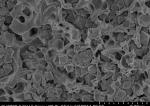Current lines
 |
 |
 |
 |
HEMPOL works on the design and development of new materials, where the design and control of surfaces and interphases plays a major role. These materials find applications in many fields such as energy, packaging, building and environmental.
- As a basis of such materials, the group specialises in the surface modification of nano and micrometric fillers: silica, sepiolite or cellulose among others, following new procedures developed by the group, and also MOF organo-inorganic fillers. These particles are studied and employed by themselves or as part of hybrids or composites with polymeric matrices, either commercial or synthesized in HEMPOL.
- Superhydrophobic hybrids and materials based on modified silica, transparent and mechanically stable at the same time. These materials find many applications as anticorrosion coatings or superslippery surfaces among others.
- Superhydrophobic conjugated polymers with electronic properties, as new water repellent electronic materials.
- Polymers incorporating metallic nanoparticles, magnetic, Au, Ag, etc, using micrometric carriers and hierarchical morphologies or otherwise. Hybrid materials with appealing medical and environmental properties .
- Thermoplastic Solid Polymer Electrolytes for Li+ batteries., extremely easy to process by conventional processing aids such as extrusion or melt compounding. High ionic conductivities and solid-like performance.
- As a common topic, the study of transport properties, ionic and molecular, by means of dielectric spectroscopy and NMR (ionic transport) or absorption and barometric method (molecular transport).
- Polymer synthesis has been for long a very active research line in the group, and still is. Currently two topics are very active in this line, the study of the kinetics of radical polymerization in the presence of ionic liquids or lithium salts, and the synthesis of conjugated polymers by cross coupling with different catalytic systems.






